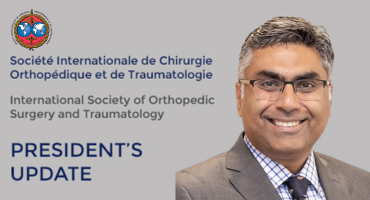 Current Progress in Orthopedics
Current Progress in Orthopedics
Ahmed Ekram (Lecturer of Orthopaedics and Traumatology)
Mohamed Kamal (Assistant lecturer of Orthopaedics and Traumatology)
Morsy Mohamed (Assistant lecturer of Orthopaedics and Traumatology)
Mohamed Alaa (Assistant lecturer of Orthopaedics and Traumatology)
Amr Atef (Assistant lecturer of Orthopaedics and Traumatology)
Saumitra Goyal (Consultant of Orthopaedics and Traumatology)
Mostafa Thabet (Senior resident)
Mohamed Abdennaeem (Senior resident)
A group of orthopaedic surgeons working at Assiut University Orthopaedic Department, Egypt, have reviewed the new SICOT book, 'Current Progress in Orthopedics'. It was intended to have a 'spectrum' of opinions ranging from the opinion of a senior resident to that of an experienced professor. All reviewers concurred that the book provides comprehensive coverage of key topics in orthopaedics and deals with the different topics in a new and interesting way. We have gathered the different opinions and put them together in a more simple and organised fashion.
Title:
The title matches the contents of the book to a great extent.
Titles of the chapters:
These titles are the strongest and the most attractive points for me to read their content.
'Is Ponseti Management the Panacea for all Clubfeet?'
'The Functional Non-Surgical Treatment of Humeral Fractures'
These titles and of course the others were chosen carefully. When I was encouraging my colleagues to review the book, I told them that these are the questions we frequently ask when this topic is mentioned! And I really want to know the answers to these questions!
Illustrations in each chapter:
They are adequate, comprehensive, and clear.
Choice of authors:
To have those great names at the beginning of each chapter is the most important factor and they grasped all our attention.
The overall reviewers’ opinions about the scientific content:
It is an excellent comprehensive review of the available literature concerning the current concepts of management and key learning points.
It is especially useful for the senior residents applying for a Masters degree exam or those preparing to take board exams.
The book is very helpful for highly specialised orthopedists who want to renew their general orthopaedic knowledge and to keep it up-to-date through interesting topics summarised by leading experts.
In most chapters the literature was reviewed thoroughly while mentioning the author's preference. This point is considered an advantage and a disadvantage for different kinds of reviewers. Some need to be directed to a certain recommended technique or opinion while others prefer deciding their own way of thinking after they have reviewed different literature opinions in an even way.
Examples of reviewers’ comments:
Chapter 19
'Defining the Role of the Cemented Stems in Total Hip Replacement Surgery'
Cemented stems have the longest follow-up results available and define the 'Gold Standard' to which other femoral implants should aspire.
On reading this chapter, there is a detailed discussion of the cemented stems.
Firstly, modes of stem fixation. Taper slip (forced closed) philosophy and composite beam (shaped) philosophy stating the definition, principles and differences in between both. Advantages of taper slip.
Secondly, the advantages and indications of cemented stems entailing a wide range of opinions in the positioning technique and revising of taper slip type.
Thirdly, an overview of results of cemented stems in history and different registries.
Also, a deeply detailed explanation of preoperative planning and surgical technique (posterior approach). You will find step-by-step instructions including tips and pitfalls through approach, positioning, femoral canal preparation, cementing technique and managing length and position of implant.
Lastly, a discussion of common faults leading to late stem insertion in proper position and how to manage.
In conclusion, I recommend this chapter to readers who want a rapid comprehensive overview of cemented femoral stems in hip replacement.
Mohamed M. Alaa
Chapter 1
'Femoroacetabular Impingement - Current Understanding'
This chapter provides an excellent overview of the concept of femoroacetabular impingement, how to diagnose, and how to treat. It defines the femoroacetabular impingement and explains its types. Then, it explains how to diagnose it clinically and radiologically with a hint about the recent advances in imaging modalities as the dGEMRIC (delayed Gadolinuim Enhancement MRI of the Cartilage). At the end, it describes different treatment modalities.
Chapter 14
'Options for Treatment of Displaced Acetabular Fractures'
This chapter can remind the orthopaedic surgeon about what he actually knows about the management of displaced femoral neck fractures with hints about the still ongoing controversies such as internal fixation or arthroplasty, cemented or cementless stems, and hemi- or total arthroplasty.
Mohammad Kamal
Chapter 15
'Operative Management of Distal Radius Fractures in Adults'
This is one of the most difficult topics to be reviewed in fractures of the upper limb. This topic is highly debatable and the literature is full of confusing opinions.
This chapter shows an excellent literature review with the advanced and up-to-date data. Indications for surgery were mentioned in a clear and precise way. Timing of surgery was written in a comprehensive way. Various techniques of pinning and internal or external fixation were displayed in a comprehensive way including the author’s preferred methods.
I would recommend this chapter to senior residents and to those specialising in upper limb trauma.
Amr Atef Abdulsalam Eisa














